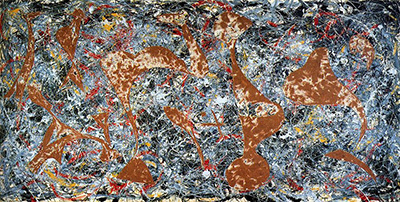Jackson Pollock's 1949 piece Out Of The Web was originally referred to simply as Number 7 and was renamed to its current title for an exhibition at Janis six years after its completion.
Even by Pollock's standards, Out Of The Web is an unusual work, utilising a Masonite canvas into which simple yet abstract forms have been carved.
The recessed areas have been left intentionally spare of paint, with Pollock allowing the natural background of the piece to provide a unique additional element.
Originally Jackson Pollock had intended the piece to be more in line with his other works and the initial surface was incredibly complex, comprising totally of multiple layers of paint which gave Out Of The Web a physical thickness unlike many other artworks.
Because of this, Pollock became unsure about the piece and decided to employ a gouging, cut out collage technique which has given Out Of The Web its unique feel and depth.
At least one of the primary forms was intended by the artist to be a 'dancing figure', although this is not as immediately obvious as Pollock first envisioned.
Out Of The Web is notable for Pollock's use of a reversed version of his usual method, with the piece featuring no intervening layer. Instead, Pollock scraped and extracted directly from the Masonite surface.
This adds an extra element of abstractness to Out Of The Web, inferring its meaning rather than stating it clearly and giving the work a heightened sense of mystery.
Interestingly, when Jackson Pollock was finished cutting out sections of his initial version of the piece, he attached the remains of one form to a set of strings and presented it to John Bernard for use as a puppet.




